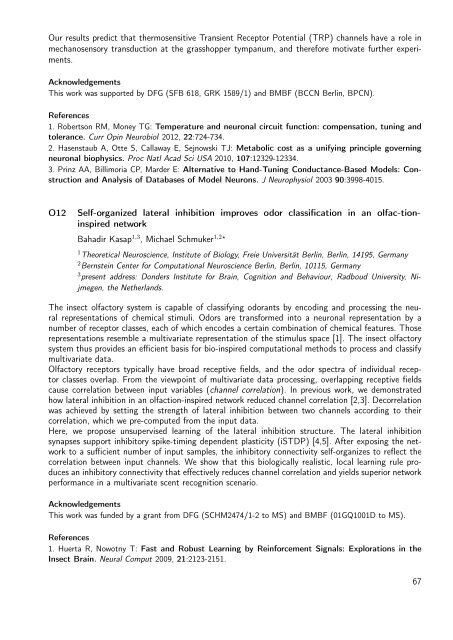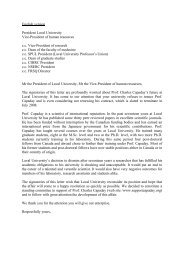Untitled - Laboratory of Neurophysics and Physiology
Untitled - Laboratory of Neurophysics and Physiology
Untitled - Laboratory of Neurophysics and Physiology
Create successful ePaper yourself
Turn your PDF publications into a flip-book with our unique Google optimized e-Paper software.
Our results predict that thermosensitive Transient Receptor Potential (TRP) channels have a role in<br />
mechanosensory transduction at the grasshopper tympanum, <strong>and</strong> therefore motivate further experiments.<br />
Acknowledgements<br />
This work was supported by DFG (SFB 618, GRK 1589/1) <strong>and</strong> BMBF (BCCN Berlin, BPCN).<br />
References<br />
1. Robertson RM, Money TG: Temperature <strong>and</strong> neuronal circuit function: compensation, tuning <strong>and</strong><br />
tolerance. Curr Opin Neurobiol 2012, 22:724-734.<br />
2. Hasenstaub A, Otte S, Callaway E, Sejnowski TJ: Metabolic cost as a unifying principle governing<br />
neuronal biophysics. Proc Natl Acad Sci USA 2010, 107:12329-12334.<br />
3. Prinz AA, Billimoria CP, Marder E: Alternative to H<strong>and</strong>-Tuning Conductance-Based Models: Construction<br />
<strong>and</strong> Analysis <strong>of</strong> Databases <strong>of</strong> Model Neurons. J Neurophysiol 2003 90:3998-4015.<br />
O12<br />
Self-organized lateral inhibition improves odor classification in an olfac-tioninspired<br />
network<br />
Bahadir Kasap 1,3 , Michael Schmuker 1,2⋆<br />
1 Theoretical Neuroscience, Institute <strong>of</strong> Biology, Freie Universität Berlin, Berlin, 14195, Germany<br />
2 Bernstein Center for Computational Neuroscience Berlin, Berlin, 10115, Germany<br />
3 present address: Donders Institute for Brain, Cognition <strong>and</strong> Behaviour, Radboud University, Nijmegen,<br />
the Netherl<strong>and</strong>s.<br />
The insect olfactory system is capable <strong>of</strong> classifying odorants by encoding <strong>and</strong> processing the neural<br />
representations <strong>of</strong> chemical stimuli. Odors are transformed into a neuronal representation by a<br />
number <strong>of</strong> receptor classes, each <strong>of</strong> which encodes a certain combination <strong>of</strong> chemical features. Those<br />
representations resemble a multivariate representation <strong>of</strong> the stimulus space [1]. The insect olfactory<br />
system thus provides an efficient basis for bio-inspired computational methods to process <strong>and</strong> classify<br />
multivariate data.<br />
Olfactory receptors typically have broad receptive fields, <strong>and</strong> the odor spectra <strong>of</strong> individual receptor<br />
classes overlap. From the viewpoint <strong>of</strong> multivariate data processing, overlapping receptive fields<br />
cause correlation between input variables (channel correlation). In previous work, we demonstrated<br />
how lateral inhibition in an olfaction-inspired network reduced channel correlation [2,3]. Decorrelation<br />
was achieved by setting the strength <strong>of</strong> lateral inhibition between two channels according to their<br />
correlation, which we pre-computed from the input data.<br />
Here, we propose unsupervised learning <strong>of</strong> the lateral inhibition structure. The lateral inhibition<br />
synapses support inhibitory spike-timing dependent plasticity (iSTDP) [4,5]. After exposing the network<br />
to a sufficient number <strong>of</strong> input samples, the inhibitory connectivity self-organizes to reflect the<br />
correlation between input channels. We show that this biologically realistic, local learning rule produces<br />
an inhibitory connectivity that effectively reduces channel correlation <strong>and</strong> yields superior network<br />
performance in a multivariate scent recognition scenario.<br />
Acknowledgements<br />
This work was funded by a grant from DFG (SCHM2474/1-2 to MS) <strong>and</strong> BMBF (01GQ1001D to MS).<br />
References<br />
1. Huerta R, Nowotny T: Fast <strong>and</strong> Robust Learning by Reinforcement Signals: Explorations in the<br />
Insect Brain. Neural Comput 2009, 21:2123-2151.<br />
67



